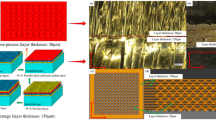Abstract
Manufacturing of micro-pins with diameter less than 1 mm is a field of great interest both in research and in industrial application. There is a wide variety of components of low-diameter cylindrical geometry for various applications, including precision products such as gear shafts, valves, shafts, and channels of micro-fluidic systems, parts for micro-pumps and turbines, etc. Increasing interest can also be found in the manufacturing of micro-electrodes for micro-hole EDM drilling of Ti- and Ni-base alloys for the aerospace industry. The inverse slab electrical discharge milling (ISEDM) process has been recently proposed as an economical alternative for the manufacturing of high-aspect ratio low-diameter cylindrical parts. However, application of the process requires understanding the influence of the process variables. The technological data given by conventional SEDM machines (static workpiece) are not valid for this process due to the relative rotation movement of the part with respect to the electrode. In this work, a systematic study of the influence of the process variables on the efficiency of the ISEDM process is presented. The geometrical characteristics of the cylindrical part, its rotational speed, and the energy of the discharge have been included in the study as main input variables. Their effect on material removal rate, surface finish, and micropin accuracy is discussed. Results show that micropins of aspect ratio as high as 90:1 and 0.2 mm diameter can be economically manufactured.
Similar content being viewed by others
References
Masuzawa T (2000) State of the art of micromachining. Ann CIRP 49(2):473–488
Fan ZW, Hourng LW (2009) The analysis and investigation on the microelectrode fabrication by electrochemical machining. Int J Mach Tools Manuf 49:659–666
Huang CA, Chang JH, Yang SY, Yang CC (2006) Preparation of a needle probe with sharp tip and high aspect ratio geometry by an electrochemical etching method. Corros Sci 48:4294–4302
Mao-Sheng L, Guan-Xin C, Zhen-Long W, Yu-Kui W, Li D (2009) Micro electrical discharge machining of small hole in TC4 alloy. Trans Nonferrous Met Soc China 19:434–439
Liu H-S, Yan B-H, Huang F-Y, Qiu K-H (2005) A study on the characterization of high nickel alloy micro-holes using micro-EDM and their applications. J Mater Process Technol 169:418–426
Kawakami K, Kunieda M (2005) Study on factors determining limits of minimum machinable size in micro EDM. Ann CIRP 54(1):167–170
Hattori R (2006) Ultra-precision micromachining using linear-motor-driven EDM machines. Die Mould Technol 21(6):28–31
Egashira K, Mizutani K (2005) EDM at low open-circuit voltage. Int J Electr Mach 10:21–26
Egashira K, Morita Y, Hattori Y (2010) Electrical discharge machining of submicron holes using ultrasmall-diameter electrodes. Precis Eng 34:139–144
DeMello AJ, Wootton RCR (2009) Miniaturization: chemistry at the crossroads. Nat Chem 1:28–29
Zhang M, Wu J, Wang L, Xiao K, Wen W (2010) A simple method for fabricating multi-layer PDMS structures for 3D microfluidic chips. Lab Chip 10:1199
Song S, Lee C, Kim T, Shin I, Jun S, Jung H (2010) A rapid and simple fabrication method for 3-dimensional circular microfluidic channel using metal wire removal process. Microfluid Nanofluid 9(2–3):533–540
Morarka A, Agrawal S, Kale S, Kale A, Ogale S, Paknikar K, Bodas D (2011) Quantum dot based immunosensor using 3D circular microchannels fabricated in PDMS. Biosens Bioelectron 26:3050–3053
Jurischka R, Schoth A, Müller C, Thiebaud D, Gallera R, Reinecke H (2006) Hard tooling by μ-EDM milling for injection moulding. Multi-Material Micro Manufacture
Chern G, Wu YE, Cheng J, Yao J (2007) Study on burr formation in micro-machining using micro-tools fabricated by micro-EDM. Precis Eng 31:122–129
Masuzawa T, Fujino M, Kobayashi K (1985) Wire electro-discharge grinding for micro-machining. Ann CIRP 34(1):431–435
Uhlman E, Piltz S, Oberschmidt D (2008) Machining of micro rotational parts by wire electrical discharge grinding. Prod Eng Res Dev 2:227–233
Egashira K, Hosono S, Takemoto S, Masao Y (2011) Fabrication and cutting performance of cemented tungsten carbide micro-cutting tools. Precis Eng 35:547–553
Bhavsar SN, Aravindan S, Rao PV (2009) A critical review of micro-tools fabrication by focused ion beam (FIB) technology, vol II. Proc. World Congress on Engineering, London
Onikura H, Onishi O, Take Y, Kobayashi A (2000) Fabrication of micro carbide tools by ultrasonic vibration grinding. Ann CIRP 49(1):257–260
Rajurkar KP, Levy G, Malshe A, Sundaram MM, McGeough J, Ul X, Resnick R, DeSilva A (2006) Micro and nano machining by electro-physical and chemical processes. Annals of the CIRP55 (1):643–666
Uhlmann E, Piltz S, Jerzembeck S (2005) Micro machining of cylindrical parts by electrical discharge grinding. Proc ISEM XIV
Rahman M, Asad ABMA, Masaki T, Saleh T, Wong YS (2010) A Senthil Kumar. A multiprocess machine tool for compound machining. Int J Mach Tools Manuf 50:344–356
Gil R, Sanchez JA, Ortega N, Plaza S, Izquierdo B, Pombo I (2012) Analysis of micro-pin manufacturing using inverse slab electrical discharge milling (ISEDM) process. J Key Eng Mater 496:247–356
Soni JS, Chakraverti G (1994) Machining characteristics of titanium with rotary electro-discharge machining. Wear 171:51–58
Waßenhoven K (1993) Funkenerosive Bearbeitung mit rotierender Stiftelektrode—Prozessanalyse und Verfahrensauslegung. Dissertation, RWTH Aachen
Karthikeyan G, Ramkumar J, Dhamodaran S, Aravindan S (2010) Micro electric discharge milling process performance: an experimental investigation. Int J Mach Tool Manuf 50:718–727
Author information
Authors and Affiliations
Corresponding author
Rights and permissions
About this article
Cite this article
Gil, R., Sánchez, J.A., Ortega, N. et al. High-aspect ratio micro-pin manufacturing using inverse slab electrical discharge milling (ISEDM) process. Int J Adv Manuf Technol 65, 1459–1469 (2013). https://doi.org/10.1007/s00170-012-4270-5
Received:
Accepted:
Published:
Issue Date:
DOI: https://doi.org/10.1007/s00170-012-4270-5




